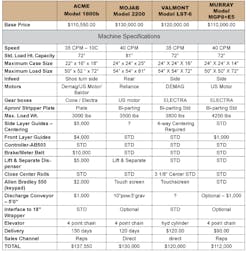If you have employed lean Manufacturing principles to reduce waste and lower costs, have high quality products, but are still losing orders to competition – then something else might be wrong.
There are two questions to ask yourself:
1. What are the reasons you are losing orders and who are you losing to?
2. Do you have a competitive advantage, that is, are your products and services competitive to other competitive products and services in the eyes of the customer.
These are vitally important question because when a customer views your product/service package as inferior to competitors or as “me too” products that are basically the same or inferior to competitor’s you are probably going to lose the order. Regardless of the unfairness of the customer’s judgment, your products or services are not viewed as the best offering, which means you may not have a competitive advantage.
Customers have product alternatives from all over the world from which to pick. Globalization has created a continuously changing environment, where products and services that had a competitive advantage last year are not competitive this year, because of new competitors entering the markets. You can push your sales people to sell as hard as they can, but in the end the customer will sit down with a bunch of competitive quotes on the table and have to choose one.
Before you go out and hire new or more sales people or invest in an expensive promotion program, do yourself a favor and find out if you have a competitive advantage with your products or services. A good place to start is to answer the question of where and why is the company losing orders?
Lost Orders
Do you know the specific reasons you lost orders to competitors? Do you know which competitor received the order? One of the best indicators of whether you have a chance to grow sales is understanding why customers buy or don’t buy from your company. The reasoning is simple – it is difficult to know what to do to prevent future lost orders or lost customers if you don’t know why you are losing current customers and orders. The second reason is that it is a waste to invest in the process and plant if your products/services are not competitive.
Keeping track of lost order information is critical to perpetuate long term growth. But the reality is that surveys show that more than 75% of manufacturers do not track lost orders and 95% do not know all of the reasons customers dropped them as a supplier. The bottom line is you can’t really develop a plan to increase sales growth or even survive in the new economy without knowing why you lose orders and customers.
Finding out about lost orders is not that difficult. Begin by developing a list of all quotations you did in the last 12 months. Then mark which ones became orders and which ones were lost. Note the real important accounts – the ones you cannot afford to lose with an X. Get everyone together who was connected to the quotes and sales effort. Now review every lost order to find the best reason. If no one has been keeping records, try to review as many of the accounts as people can remember and go through the list quickly to determine the general reasons. You will probably find that many of the lost order reasons are not known. Some will be very obvious and other reasons may be simply guesses. From experience I can tell you that for packaging machinery typical reasons are price; couldn’t meet specs; lead time; weak sales rep; responded too late, superior competitor product; and unknown.
Next comes what may seem difficult; but it’s critical. You or someone else at your company – such as the appropriate sales person – will have to call each of these customers and find out the real reason for their decisions. If you don’t have a person or the time to get the answers, hire an outside service to get it done. In some ways, finding out about lost orders is as important as getting orders. No matter how boring, time consuming or tedious the customer calls are you have to find out the reasons – it is vital to the long term growth of the company.
There are 4 types of information you can gather on lost orders that will help you in making strategy decisions:
• Customer Information — If you can find out the real or complete reason the customer decided to buy a competitor’s product, you will have an insight as to what strategy you must change in the future to get the customer back or get the next order.
• Model Information — Grouping lost orders by model reveals which products might not have competitive advantage and should be considered for redesign or a pruning decision.
• Competitive Information —It is necessary to find out exactly which competitors you are losing to. For example, I was recruited in 1998 to turn around a division that made packaging machinery. They did not use a lost order process so I had to immediately try to find out why they were losing orders and market share. I quickly found out that there were 49 competitors built similar machines. But after a year of pursuing lost orders I found out that 90% of our lost orders were to 3 competitors. This revelation allowed me to focus our resources and strategies on competing against these 3 competitors.
Competitive Comparisons
The second big question is how do your products and services match up to the other direct competitors from the customer's point of view, and how do your prices compare to the competitor’s prices in an apples-to-apples comparison?
If you cannot answer these basic questions, then you will find out at the point of sale whether you have competitive advantage or not. It goes without saying that it is very expensive to find out you do not have a saleable product or service at the point of sale.
A good place to start, to begin finding out more about your competitors is to create a simple matrix. On the top of the page, list all of the direct competitors for a specific model. On the side of the page, list some key specifications, speeds, capacities and sell prices and other factors you know are important in a customer’s buying decision. Now fill in the information that’s been gathered from their literature and websites into the matrix. Leave a question mark (?) where you do not know the answers and three question marks (???) if the information is vital. This exercise is a quick way to find the information gaps that are currently not known. The gaps will also help anyone who is going to help you look for the missing information. Some times it may be necessary to go into the field and interview customers to get the data needed to answer all of the questions and develop a good matrix.
In the mid 1980s I was given the task by a N.W. foundry of steel castings to develop a competitive matrix for bucket teeth on large machines used in rock quarries. Caterpillar dominated this market for bucket teeth and the company wanted to make a competitive product to gain market share.
I began my investigation at a quarry in North Carolina and worked my way across the South to Arizona gathering price and model information. At a dinner meeting with a dealer in Phoenix he casually mentioned that competitors including Caterpillar were importing castings from Brazil and South Korea. After a few martinis he showed me the landed sell prices of the imported castings. When I compared these prices with the estimated costs of my clients proposed castings I found that the imported casting sell prices were below our costs, and there was no way to compete by making bucket teeth in the U.S.( It was my first encounter of what would be called globalization)
My effort to see if the new proposed casting line would have a competitive advantage had really paid off. It would have cost about $250,000 to design and manufacturer a competitive line of products that would not sell in this market place. We dodged a bullet and the costs of the research were miniscule to the planned investment,
If you know you cannot gather this information or simply do not have the time, hire a third party to go after it. They can make phone calls to all the selected competitor companies and ask for their literature, prices and channel information. Give them the competitor matrix you constructed, with the information gaps, and ask them to go after this gap information. They can search a number of on-line databases, trade directories, association directories and credit reports for information on both direct and indirect competitors. Third parties can often get competitive information that you cannot get.
The final competitor matrix should look like the following:
This real life example shows the value of finding out “apple to apples” information with comparative pricing. Acme had made the classic mistake of setting a base price for a machine that looked to be $10,000 to $20,000 below most competitors’ base prices. But when the machine was configured with options to match the competitor machines the total price was above all competitor prices and not competitive in the eyes of the customer. As a result of this finding, ACME had to completely redesign the Model 1800b to gain a competitive advantage I know what you are thinking – Gee I never had to do this kind of information gathering before-is it really worth the effort? If growth in sales is the primary objective, you are going to have to make a bunch of strategy decisions on current products, new products, advertising and promotion, pricing, sales channels etc. These are all money decisions. Shouldn’t you make sure you have a competitive advantage before investing? In addition if you have spent a lot of time and money on Lean Manufacturing, ISO 9000 and other internal efficiency programs but are still losing orders, perhaps it is in your best interest to find out why
The bottom line is that you will have to have some kind of competitive advantage with your products and services if you want to grow and find new customers and market opportunities.
Mike Collins is the author of "Saving American Manufacturing" and the Growth Planning Handbook. He is also the President of MPC Management.




